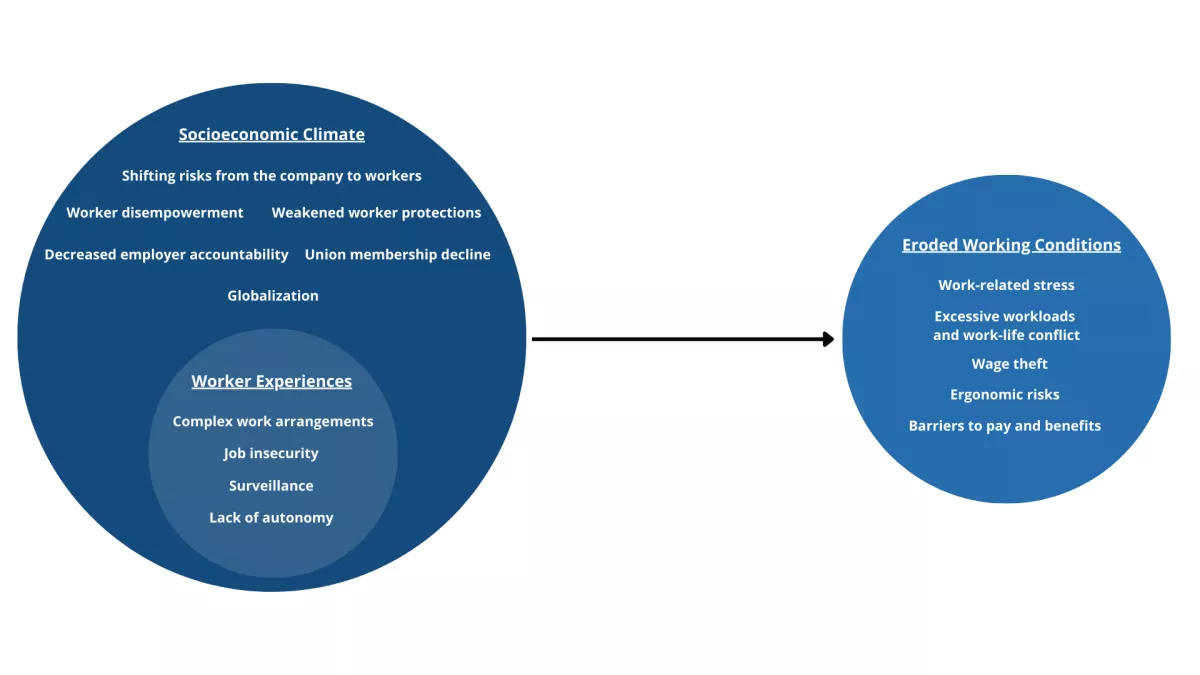By Ima Varghese Mac, Alicia LaFrance, MPH, MSW
July 31, 2023
With the rise of remote jobs, gig work, and new technology, the way people work has shifted drastically. Work-life boundaries have blurred, algorithms have replaced supervisors, and employers are increasingly outsourcing their labor. These emergent working conditions lead to new challenges for the workforce. Broader socioeconomic trends, such as globalization, the decline in union membership, the shift of risks from the company to workers, and corporate opposition to government regulations of employment, have also left workers less protected from the harmful effects of work.
In 2022, the CA Labor Lab conducted a series of qualitative interviews among workers, union leaders, and academic researchers, in preparation for a statewide survey of working-age Californians. These respondents gave valuable insights into the problems workers in California face. Using data gathered from the qualitative interviews and the survey, we hope to better characterize the complex issues affecting workers and offer insights into how to address these issues.
Findings reveal the intricacies of current work arrangements
The interviews demonstrated the complexity present in individuals' work arrangements. One respondent discussed the convoluted nature of her previous employment arrangement. She began by describing how she acquired a warehousing job through a temp agency. Within the warehouse, there was a company that delivered gourmet products and one that delivered floral arrangements. Although she was hired to work for the gourmet product company, her day-to-day tasks involved handling flowers. She described her confusion surrounding the work arrangement, especially when accurately representing her position on a resume.
An expert on warehouse work, Dr. Ellen Reese, further illustrated how tangled warehousing employment can be for workers. She explained that warehouse workers are often hired by temp agencies, which provide their services to third-party logistics companies. However, the products that warehouse workers interact with daily usually belong to a large multinational retailer. Although the workers may have intimate knowledge of the retailer's products and operations, they are not directly employed by the retailer or the third-party logistics companies for which they perform the work. These examples display the labyrinthine quality of modern work arrangements.
Job insecurity and autonomy are growing concerns for many workers
Workers in California also face high levels of uncertainty surrounding job stability. Various forms of employment, such as seasonal, shift, and app-based (“gig”) work, prevent workers from having a reliable source of income. During an interview, Nicole Moore, a rideshare driver and president of Rideshare Drivers United expressed her concerns: "There is no job security and the companies can deactivate us for any reason, or no reason." She explained that deactivation decisions are based on algorithms designed to detect fraudulent activity. However, the algorithms are not always accurate and lack transparency, leaving workers without a job or an understanding of how to avoid this problem in the future. This omnipresent surveillance that app workers experience also contributes to another salient concern in the California labor market: a lack of autonomy.
One might assume that jobs providing flexibility, such as gig work, would offer a certain level of autonomy. However, the reality is quite different. The level of monitoring that many workers now experience has wide-reaching implications for how they carry out their jobs. One respondent described her firsthand experiences working for an app-based food delivery company, stating, "They keep stats for you, like the percentage of jobs that you accept, the percentage of jobs that you complete on time... if you communicate with the person that you're shopping for or delivering to... [and] you're good at that, then you get a high percentage rate... [but] they will also inform somebody that they can't work anymore if certain stats are too low." These threats to worker autonomy restrict them from making their own decisions and may increase the work stress they endure.
Problems in the organization of work create poor working conditions
The California labor market is a reflection of the evolving nature of work in the modern world. As complexities, uncertainties, and surveillance continue to characterize the work experience, it is essential to recognize the negative impact on workers' rights, health, and well-being. The CA Labor Lab hypothesizes that the combined impact of these job characteristics leads to poor working conditions, including:
- Excessive workloads and work-life conflict
- Increased ergonomic risk
- Barriers to pay and benefits
- Wage theft
- Increased work-related stress
These conditions disempower workers by making it confusing and exhausting for them to advocate for better working conditions. They also are markers of eroding employer accountability to provide safe working conditions for their employees.
Promoting Positive Change
Addressing these challenges requires concerted efforts from various stakeholders, including policymakers, employers, and workers themselves. The CA Labor Lab aims to remedy these circumstances by helping workers and policymakers understand the relationships among contemporary working conditions and the health and well-being of the working age population.
Related Resources:
- 35 Years Under Electronic Monitoring and Still Waiting for Worker Rights
- Fired by an App: Rideshare Drivers' Experience with Discrimination, Harassment, & Unfair Termination
- Workplace Technology and Worker Well-Being

